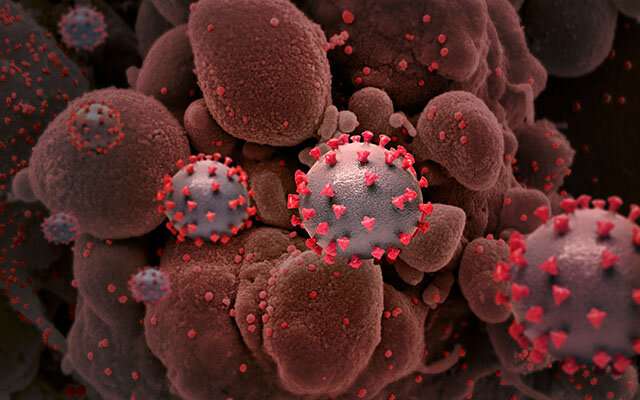Creative rendition of SARS-CoV-2 particles (not to scale). Credit: National Institute of Allergy and Infectious Diseases, NIH
Only 21 percent of patients with severe pneumonia caused by SARS-CoV-2 (the virus that causes COVID-19) have a documented bacterial superinfection at the time of intubation, resulting in potential overuse of antibiotics, according to new research published online in the American Thoracic Society's American Journal of Respiratory and Critical Care Medicine. Superinfection takes place when another, often different, infection is superimposed on the initial infection; in this case, bacterial pneumonia occurring during severe viral pneumonia.
In "Bacterial Superinfection Pneumonia in Patients Mechanically Ventilated for SARS-CoV-2 Pneumonia," Richard G. Wunderink, MD, professor of medicine, Division of Pulmonary and Critical Care, Northwestern University Feinberg School of Medicine, and co-authors report on a study that shows that the usual clinical criteria used to diagnose bacterial pneumonia could not distinguish between those with bacterial superinfection and those with severe SARS-CoV-2 infection only.
According to the authors, current guidelines that recommend that patients with SARS-CoV-2 pneumonia receive empirical antibiotics (antibiotics given based on the presumption of infection, rather than based on actual detection of a bacteria) initially on hospital admission for suspected bacterial superinfection are based on weak evidence. Rates of superinfection pneumonia in other published clinical trials of patients with SARS-CoV-2 pneumonia are unexpectedly low.
"More accurate assessment other than just reviewing clinical parameters is needed to enable clinicians to avoid using antibiotics in the majority of these patients, but appropriately use antibiotics in the 20-25 percent who have a bacterial infection as well," said Dr. Wunderink.
The team conducted an observational single center study at Northwestern University to determine the prevalence and cause of bacterial superinfection at the time of initial intubation and the incidence and cause of subsequent bacterial ventilator-associated pneumonia (VAP) in 179 patients with severe SARS-CoV-2 pneumonia requiring mechanical ventilation.
They analyzed 386 bronchoscopic bronchoalveolar lavage (BAL; a procedure to collect samples from deep in the lungs) fluid samples from patients using quantitative bacterial cultures—which help clinicians determine how many bacteria are present—and a multiplex polymerase chain reaction (PCR) panel. Actual antibiotic use was compared with guideline-recommended therapy. Bacterial superinfection within 48 hours of intubation was detected in 21 percent of patients; 72 patients (44.4 percent) developed at least one VAP episode; 15 (20.8 percent) of initial VAPs were caused by difficult-to-treat bacteria.
The authors found that in patients with SARS-CoV-2 pneumonia requiring mechanical ventilation, bacterial superinfection at the time of intubation occurred in less than 25 percent of patients. Guideline-based empirical antibiotic management at the time of intubation would have resulted in antibiotic overuse. Dr. Wunderink and colleagues believe that their findings have multiple implications for antibiotic guidelines: "Rapid diagnostic tests are important for helping identify suspected pneumonia in intubated patients. This can have major clinical implications because the current approach of using clinically defined risk factors for suspected methicillin-resistant staphylococcus aureus (MRSA) or pseudomonas bacteria as the cause of pneumonia still grossly overestimate the true incidence of these pathogens. In addition, the recommendation for empirical antibiotic treatment of worsening viral community-acquired pneumonia (now requiring intubation) may need to be revisited. This is not only true for SARS-CoV-2 but potentially for severe influenza as well."
"An accurate diagnosis of suspected pneumonia allows clinicians to safely avoid or use narrow spectrum antibiotics for many patients," Dr. Wunderink added. "While multiple interventions impact mortality in these critically ill patients, the low mortality in our study with more limited antibiotic treatment suggests that our approach was safe."
More information: Chiagozie O. Pickens et al, Bacterial Superinfection Pneumonia in Patients Mechanically Ventilated for COVID-19 Pneumonia, American Journal of Respiratory and Critical Care Medicine (2021). DOI: 10.1164/rccm.202106-1354OC
Journal information: American Journal of Respiratory and Critical Care Medicine
Provided by American Thoracic Society
























